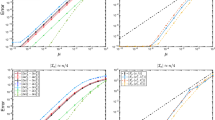Abstract
We study the problem of finding a point in the relative interior of the optimal face of a linear program. We prove that in the worst case such a point can be obtained in O(n 3 L) arithmetic operations. This complexity is the same as the complexity for solving a linear program. We also show how to find such a point in practice. We report and discuss computational results obtained for the linear programming problems in the NETLIB test set.
Similar content being viewed by others
References
I. Adler and R.C. Monteiro, “A geometric view of parametric linear programming,” manuscript, Department of Industrial Engineering and Operations Research, University of California (Berkeley, CA, 1989).
R. Bixby, “Implementing the simplex method: the initial basis,”ORSA Journal on Computing 4 (1992) 267–284.
G.B. Dantzig,Linear Programming and Extensions (Princeton University Press, Princeton, NJ, 1963).
A.S. El-Bakry, R.A. Tapia and Y. Zhang, “A study of indicators for identifying zero variables in interiorpont methods,” TR 91-15, Department of Mathematical Sciences, Rice University (Houston, TX, 1991).
R. Fourer and S. Mehrotra, “Solving symmetric indefinite systems in an interior-point method for linear programming,”Mathematical Programming (Series B) 62 (1993) 15–39.
R.M. Freund, R. Roundy and M.J. Todd, “Identifying the set of always active constraints in a system of linear inequalities by a single linear program,” Technical Report, Sloan W.P. No. 1674-85 (MIT, Cambridge, MA, 1985).
D.M. Gay, “Stopping tests that compute optimal solutions for interior-point linear programming algorithms,” Numerical Analysis Manuscript 89-11, AT&T Bell Laboratories (Murray Hill, NJ, 1989).
D.M. Gay, “Electronic mail distribution of linear programming test problems,”Mathematical Programming Society News Letter, 10–12.
A.J. Goldman and A.W. Tucker, “Theory of linear programming,” in: H.W. Kuhn and A.W. Tucker, eds.,Linear Inequalities and Related Systems, (Princeton University Press, Princeton, NJ, 1956) pp. 53–97.
C.C. Gonzaga, “An algorithm for solving linear programming problems in O(n 3 L) operations,” in: N. Megiddo, ed.,Progress in Mathematical Programming — Interior Point and Related Methods (Springer, New York, 1989) pp. 1–28.
O. Güler and Y. Ye, “Convergence behavior of interior-point algorithms,”Mathematical Programming 60 (1993) 215–228.
M. Kojima, S. Mizuno and A. Yoshise, “A polynomial-time algorithm for a class of linear complementarity problems,”Mathematical Programming 44 (1989) 1–26.
N. Megiddo, “On finding primal- and dual-optimal bases,”ORSA Journal on Computing 3 (1991) 63–66.
S. Mehrotra, “Quadratic convergence in a primal—dual method,”Mathematics of Operations Research 18 (1993) 741–751.
S. Mizuno, M.J. Todd and Y. Ye, “On adaptive-step primal—dual interior-point algorithms for linear programming,” (1990), to appear in:Mathematics of Operations Research.
R.C. Monteiro and I. Adler, “Interior path following primal—dual algorithms. Part I: Linear programming,”Mathematical Programming 44 (1989) 27–41.
J. Renegar, “A polynomial-time algorithm, based on Newton's method, for linear programming,”Mathematical Programming 40 (1988) 59–93.
A. Schrijver,Theory of Linear and Integer Programming (Wiley, New York, 1986).
É. Tardos, “A strongly polynomial algorithm to solve combinatorial linear programs,”Operations Research 34 (1986) 250–256.
M.J. Todd, “A low complexity interior-point algorithm for linear programming,”SIAM Journal on Optimization 2 (1992) 198–219.
P.M. Vaidya, “An algorithm for linear programming which requires O(((m+n)n 2+(m+n)1.5 n)L) arithmetic operations,”Mathematical Programming 47 (1990) 175–202.
Y. Ye, “On the finite convergence of interior-point algorithms for linear programming,”Mathematical Programming (Series B) 57 (1992) 325–335.
Y. Ye, O. Güler, R.A. Tapia and Y. Zhang, “A quadratically convergent\(O\left( {\sqrt {nL} } \right)\)-iteration algorithm for linear programming,”Mathematical Programming 59 (1993) 151–162.
Author information
Authors and Affiliations
Additional information
Research supported in part by NSF Grant CCR-8810107, CCR-9019469 and a grant from GTE Laboratories.
Research supported in part by NSF Grant DDM-8922636 and NSF Coop. Agr. No. CCR-8809615 through Rice University.
Rights and permissions
About this article
Cite this article
Mehrotra, S., Ye, Y. Finding an interior point in the optimal face of linear programs. Mathematical Programming 62, 497–515 (1993). https://doi.org/10.1007/BF01585180
Received:
Revised:
Issue Date:
DOI: https://doi.org/10.1007/BF01585180




